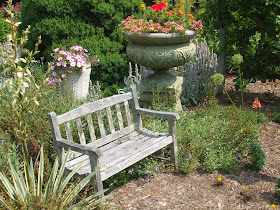Every year since 1995, the
International Herb Association has chosen an Herb of the Year™ to highlight. The Herb of the Year™ Program, spearheaded by IHA’s Horticulture Committee, has established Herb of the Year™ selections up to 2020. Long-standing member, Chuck Voigt, who has been involved in the selection process for many years explains, “The Horticultural Committee evaluates possible choices based on them being outstanding in at least two of the three major categories: medicinal, culinary, or decorative.”
And for 2015 the Herb of the Year is SAVORY.
Summer Savory is an annual herb that has tender leaves. Winter Savory is a perennial herb that is pictured above and has firmer leaves and stems. It grows into a lovely bush like shape and in the summer gets loaded with beautiful white flowers.
Savory happens to be one of International Herb Association Member Marge Powell's favorite herbs. Here’s why:
- It tastes a bit like thyme but is easier to use and dry
- It is easy to start from cuttings
- It is one of the Herbs de Provence
- It has a strong (or pungent) culinary scent
- It is a beneficial addition to many recipes
Merriam-Webster defines the word “savory” as having a pleasant taste or smell; having a spicy or salty quality without being sweet; or morally good. I do not know the etymology of the name of the word savory, but I doubt it is a coincidence that the dictionary definition describes exactly the types of dishes in which the herb savory would a beneficial addition. However, calling the herb savory “morally good” is quite a stretch unless we drop the “m”.
HERBES DE PROVENCE BLEND
Makes ½ cup
2 tablespoons dried thyme
2 tablespoons dried marjoram
2 tablespoons dried savory
1 tablespoon dried rosemary
2 tablespoons dried lavender flowers
Combine all ingredients in a blender process on a low to medium setting for about 10 seconds or until the lavender has been broken down into very small pieces. Store in an airtight container.
 This book has been around for a while but I was lucky enough to get my own copy recently. Author Thomas J. Epel has a terrific way of breaking down botany to a very readable and easy to understand level. He breaks it down in a logical way -- in fact he even has a section titled "Start here" just in case you are tempted to begin in the middle. I love the line drawings that are all through the book as they are perfect illustrations for what is being taught.
This book has been around for a while but I was lucky enough to get my own copy recently. Author Thomas J. Epel has a terrific way of breaking down botany to a very readable and easy to understand level. He breaks it down in a logical way -- in fact he even has a section titled "Start here" just in case you are tempted to begin in the middle. I love the line drawings that are all through the book as they are perfect illustrations for what is being taught. 

















































